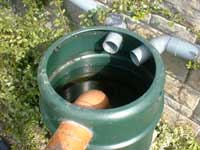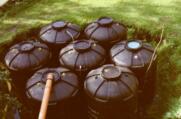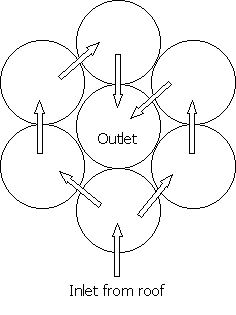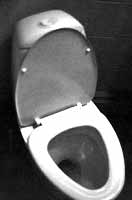
Water
There are increasing environmental problems in relation to centralised water supply such as the need for new reservoirs and the over-extraction of groundwater.
There are three aspects that need considering:
- Reducing water use
- Rainwater harvesting
- Reusing water
Reducing water useA large percentage of water is flushed down the loo. Solutions include compost loos, or low-flush toilets. We decided not to have a compost loo because we have no cellar and already have a connection to a good, local sewage treatment plant. We choose Ifö low-flush toilets.
|
|
Rainwater Harvesting
If most buildings collected rainwater from their roofs, at least for garden use, this would drastically reduce the need for centralised supplies. It would make sense for rainwater harvesting to be included in future building regulation.
Story of a raindrop that lands on our roof
|
All of the catchment area of the roof is slate, we avoided lead flashings. The water goes through zinc guttering and down drains into a hopper which has a large bottle brush 'coarse filter' in the outlet to catch leaves and large debris. |
 |
|
The water is led into a 150 litre water butt. The outlet to the main storage tanks is taken from just below the surface of the water to avoid floating debris. |
 |
| This water goes into the first of seven 2000 litre recycled orange juice containers. |
 |
|
Each tank is connected 10cm from the bottom to the tanks either side of it. The two furthest from the inlet are connected to the central tank which has the outlet for the house and garden supply. This succession means that the containers act as settling tanks. Water is pumped from 20cm above the bottom of the central tank by a pump inside the house that uses a pressurising chamber to give the equivalent of mains pressure. The pump only comes on when the pressure in the chamber drops. |
 |
The water then goes through a string filter and inflow Ultra Violet treatment unit which make to water fit for drinking. The water then enters the cold water supply for the house. We can switch to mains supply if needed and we have a third tap in the kitchen that always has mains water.
We used a figure for
the rainfall in our region and the area of the roof to work out the volume
of water that we would catch over a year. It turns out that this is not
a very useful figure because when it is rainy you collect much more water
than you need. The important figure is the volume of storage you need
to keep your water supply going during a drought.
Most water bills now tell you your usage. We took our daily water use
for four people (approx. 300l) and multiplied it by the longest period
that we thought we might have a drought. We worked on about six week's
supply of water meaning that we needed 13000 litres of storage.
Reusing water
See the water treatment page
What you can do
Reducing water use
Use a compost loo
or low-flush toilet (camphill water).
Choose a washing machine with reduced water use.
Fix low-flow shower heads and taps.
Share baths or use the shower.
Fix leaks as soon as you spot them.
Rainwater harvesting
Get a rainwater butt for garden use or toilet flushing. You can get ones that attach to your down drain and automatically stay full. Contact The Tank Exchange 01226 203852.
Consider rainwater
collection for your house supply.
We bought the 2000l reused orange juice containers for use as rainwater
storage tanks from The tank exchange 01226 203852
Marshal Pumps supplied our pump, filter and UV treatment unit. We have a Jet61 MP pump, a AC10 filter with 10 micron filter cartridge, and a UVAQ3-series UV disinfection unit. We have had no trouble with any of them. tel: 0161 6786111
See the 'What you can do' page for a compilation of tips and links from all sections.
| Home | Principles | Solar | Conservatory | Insulation & Glazing |Energy | Materials | Water | Water Treatment | Land | Report | links | Thanks | Contact us | What you can do |
![]() Web Design by Robin de Carteret 2002 (copyleft)
Web Design by Robin de Carteret 2002 (copyleft)
